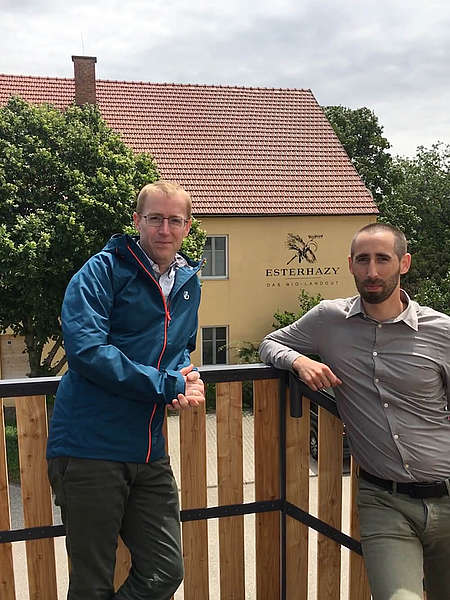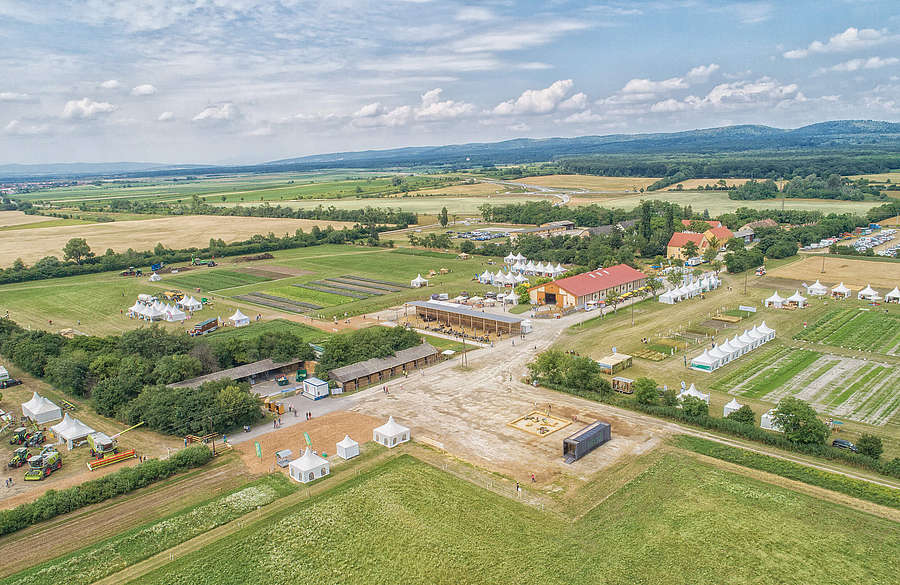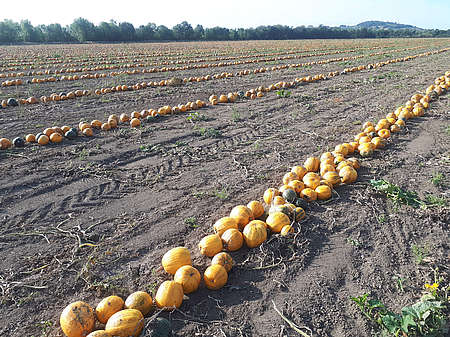Cultural mission
In May and June, the HORSCH Practical Field Days 2020 should have taken place on farms in France and in Austria, combined with an extensive programme. Corona, however, destroyed these plans. The event in Austria would have taken place at the Seehof in Donnerskirchen which is part of the Esterhazy estates. The two managing directors of the Bio-Landgut Esterhazy, David Goldenits and Johannes Niegl, present the farm in terraHORSCH instead.

terraHORSCH: Please tell us about yourself and your tasks at the Bio-Landgut Esterhazy.
Johannes Niegl: I have been one of the farm managers of the Bio-Landgut Esterhazy since 2018 and I am mainly responsible for the commercial sector. I studied business administration and grew up on a small part-time farm. In addition to the business management topics I also intensely deal with digitisation that more and more finds its way into the agricultural sector. We include geocoded data in our operative everyday life as well as in the basic strategic planning of our estate. For us, it is an important topic for the future we do not want to ignore.
David Goldenits: I am responsible for the operative farm management in the sectors farming, livestock husbandry and nature protection. I joined the Bio-Landgut in 2013. I started as an assistant and as the challenges rose, I took on more and more responsibility. Like my colleague Johannes Niegl I also grew up on a farm, an organic farm with a focus on vegetable growing. I complemented this valuable practical background by studying agricultural and nutritional sciences as well as organic farming at the University for Natural Resources and Life Sciences.
terraHORSCH: Let’s take a closer look at the Bio-Landgut. What are the climatic conditions? What is the annual rainfall? What about the prevailing types of soil?
David Goldenits: The Bio-Landgut Esterhazy is located in the region of the Lake Neusiedl in the east of Austria. The climate is continental, marked by very cold winters and very hot summers with up to 40°C. We are situated in one of the warmest and driest regions of Austria. The annual rainfall amounts to only 450 to 600 mm. This considerably influences our actions on the farm, especially with regard to the correct choice of crop types and varieties. Moreover, the region around the Lake Neusiedl is very windy and because of the resulting wind erosion we have to face enormous challenges especially in spring. We counteract this with targeted measures like planting local tree and shrub species as a shelter belt and we rely on building up humus. Soil analyses that are carried out every year by the Machinery Ring Styria – Competence Centre Nutrient Management showed that due to a consequent cultivation the humus ratio at our sites has been raised to 5 %. The types of soil range from shallow, sandy crushed stones to heavy, loamy clay. The average soil points of our fields, however, amount to only 38. Our sites are at a height of 113 m NN to 400 m NN and range within a radius of 60 km.
terraHORSCH: The Seehof in Donnerskirchen is one of the main pillars of the Esterhazy estates. What exactly is behind the name Esterhazy?
Johannes Niegl: For more than four centuries the Esterhazy family left a mark in the Pannonian area. During the turmoil of the Second World War they lost most of their land in Hungary. In the Burgenland in Austria, however, they kept 44,000 ha. The last prince Paul V. Esterhazy wanted to maintain the possessions and cultural assets of the family for the following generations. His wife Melinda Esterhazy made his wish come true and in 1994 established several indissoluble foundations. The scope of activity of the Esterhazy Foundations ranges from agriculture and forestry including nature protection, viticulture, real estate management and development to tourism and culture.
David Goldenits: Among others, the objective of the foundations is a healthy and modern growth of the enterprises. Moreover, the resulting yields are to be used to maintain the historic monuments and cultural collections and make them accessible to the public. In 2002, the Bio-Landgut Esterhazy was one of Austria’s largest organic farms – and one of the first large farms, too – to convert all fields they farmed themselves to an organic cultivation system. There are several farm sites, but at the moment the focus is on the Seehof near Donnerskirchen. It is extended as a model farm that can be visited and where large events take place regularly. For example, the Organic Field Days that after a successful start in 2018 will be repeated in June 2021.

terraHORSCH: How many hectares do you cultivate?
David Goldenits: We manage 5,600 ha of arable land 2,200 ha of which are farmed under the brand Bio-Landgut Esterhazy. The remaining area is rented to third parties. Our medium-term objective is that on all Esterhazy fields production is carried out organically and under one common brand. Besides another 22,400 ha of forest area about 16,000 additional hectares are not used or are used to only a limited extent. They are at the disposal of nature and species protection concerns.
terraHORSCH: Which objective do you want to achieve with your type of farming?
Johannes Niegl: In 2002 the Esterhazy Foundation stroke a new path. Agriculture was to take centre stage again and be promoted in public. Though already before 2002 the Esterhazy estates farmed quite successfully, nobody in the region knew the farms. By now there are a lot of events on the farms. For example, at the Seehof, in addition to the organic field days, there is a farm festival every year. Thus, we have much more visitors on our farm. The logical consequence was to build a modern meat factory, a visitor centre and a seminar room. Being a model farm, we wanted to take on responsibility – towards nature and society with its social and cultural values. The bond with the land, the region and its population is an important principle our actions are based on. This responsibility is not only lived in the company, but is also carried beyond its borders.
terraHORSCH: To what extent does this influence the marketing of your products?
David Goldenits: All products from the forests, the farms and from rock quarrying are marketed by our company “PANNATURA”. A great deal of the crops we grow like wheat, grain legumes and various oil plants are processed by our company or together with partners. We also market the eggs of the laying hens of our mobile hen house at the Seehof or the honey that is gathered by bees on the Esterhazy field under this brand. The meat of our Angus cattle as well as the venison from our numerous hunting grounds are processed into burger patties or smoked ham in our new meat factory at the Seehof. These and other refined products as well as our flour, biscuit and plant oil line are sold locally in our market hall in Eisenstadt or also in supermarkets all over Austria. We also have started using our own food trucks for our events and at our sites. We will even increase the investments in this sector to encourage not only production but also regional sales. In the future, we want to offer the tenants of our arable fields these marketing possibilities via our company “PANNATURA” respectively via the brand Bio-Landgut Esterhazy. Thus, they have the chance to counteract price fluctuations and to be able to refine their products and market them regionally.
terraHORSCH: Which crops do you grow? Please also describe your rotation.
David Goldenits: With a ten-part rotation we make the most of our sites. The ratio of grain legumes amounts to 20 %. We mainly focus on soybeans and field beans, winter peas and we use vining peas as a catch crop. The most important crops however still are food cereals, especially winter wheat and winter brewing barley. Cereals are ideal for our climatic conditions. Due to the heat, the drought and the wind in summer, the fungal infestation in winter wheat is rather low. The yield amounts to an average of 3.3 tons per hectare. Winter brewing barley has become very important for us as we together with a local brewery have included our own organic beer in our range of products. Other cereals we grow are rye, spelt and spring oats. Oats is mainly sold to a wholesaler, in average we harvest 4 tons per hectare. About one quarter of our arable land is used for growing fodder for our livestock husbandry. Our focus definitely is on the cultivation of food crops. As our region is very dry, we can irrigate 35 % of our fields, more than one third of them has already been electrified. As ground water is too deep and as we lack surface water it will not be possible to use irrigation on a lot of our fields. On these fields we regulate the problems caused by the drought via cultivation management, e.g. a deep loosening combined with an only shallow and all-over cultivation, and we adapt rotations with drought-stress tolerant crops.
terraHORSCH: Do you also grow old varieties or special crops?
David Goldenits: Yes, we do. The cultivation of special crops plays an important role. We grow for example oil squashes. For due to its high drought tolerance they are ideal for our sites. The average yield amounts to 400 kg of dried seeds per hectare. We also have been gathering experiences with regard to the cultivation of chickpeas. We handle the massive pest infestation with cultivation times that are adapted to our sites and targeted irrigation applications. Compared to other grain legumes chickpeas much better cope with drought. In the past, we also grew old varieties like emmer and einkorn wheat. The yields we achieved were quite satisfactory. However, to sell these two old wheat species on the market turned out to be difficult. For the next organic field days, we are planning a comprehensive organic species display with more than 170 different varieties, among them also emmer and einkorn wheat. Perhaps we will manage to make them known to the public and to integrate them again in our rotation in the future.
terraHORSCH: Are there any other projects for the future?
Johannes Niegl: Apart from the projects we have already mentioned we have quite a lot of plans for the future – with regard to a further modernisation of farming as well as to public relations.
To do so, we will realise further building projects in the near future. We will invest quite a lot of money in developing the parts of the Seehof that are open to and interesting for the public even further. The attic of the old grain store has already been converted to a seminar room and the old forgery has become an event room. The emphasis is always on turning the Seehof into a location where society can develop an awareness for food and its production.
terraHORSCH: How did the co-operation with HORSCH come about? What do you expect from this co-operation?
David Goldenits: On our farm festivals and other events we realised how important it is to get in contact with professional colleagues and consumers. We consider this to be a connecting factor with other companies. We are trying to find co-operation partners who support us and with whom we can organise common projects. With HORSCH we found a perfect partner. Due to our location in the agglomeration between Vienna, Bratislava and Budapest we offer the ideal patch towards Eastern Europe – regions where HORSCH is very present. We hope that due to this co-operation we will be able to address even more visitors who otherwise might perhaps not come to visit us. In addition to their own practical field days HORSCH this year would also have taken part in our organic field days which had been scheduled to take place in June some days before the HORSCH field days. HORSCH has already announced that they will participate in the organic field days 2021. We are looking forward to realising other common projects in the future.
